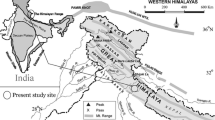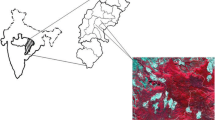Abstract
Ground macrolichens dominated by several species of fruticose Usnea spp. with foliose Leptogium puberulum constitute an important component of the terrestrial ecosystem of James Ross Island. Long-term monitoring of lichen communities in respect to their reaction to ongoing climatic changes in this part of Antarctica became a research task for scientists in recent years. The non-destructive estimation of lichen biomass provides data necessary for the management and protection of Antarctica. We have developed and tested the methodology of non-destructive estimation of biomass of fruticose Usnea species, which predominate in the ice-free tertiary basalt outcrop areas on James Ross Island. In 38 experimental squares (non-destructive measurements), the density and height of lichen thalli were measured and digital photography with ground cover evaluation was performed. Lichen biomass was harvested from 14 experimental squares and analysed for dry mass, chlorophyll a, b content, and thalli surface area (TSA). Predictive linear models were constructed from available non-destructively measured variables with the aim to maximize predictive accuracy for the destructively measured attributes. A total of 82.3 % of variability in the TSA values was explained (87.5 % for biomass determination). Cross-validated prediction error for lichen TSA estimation was 423 cm2 (11.5 % of the average TSA). In the case of lichen dry mass determination, cross-validated prediction error was 4.53 g m−2 (7.3 % of the average dry mass). This study proves that macrolichens in maritime Antarctica can be monitored non-destructively by simple field methods combining digital photography and measurements of lichen thalli in botanical squares.





Similar content being viewed by others
References
Alaback PB (1986) Biomass regression equations for under-story plants in coastal Alaska: effect of species and sampling design on estimates. Northwest Sci 60:90–103
Benedict JB (1991) Experiments on lichen growth II. Effects of a seasonal snow cover. Arct Antarct Alp Res 23:189–199
Callaghan TV, Björn LO, Chernov Y, Chapin T, Christensen TR, Huntley B, Ims RA, Johansson M, Jolly D, Jonasson S, Matveyeva N, Panikov N, Oechel W, Shaver G, Elster J, Jónsdóttir IS, Laine K, Taulavuori K, Taulavuori E, Zöckler Ch (2004a) Responses to projected changes in climate and UV-B at the species level. Ambio 33:418–435
Callaghan TV, Björn LO, Chernov Y, Chapin T, Christensen TR, Huntley B, Ims RA, Johansson M, Jolly D, Jonasson S, Matveyeva N, Panikov N, Oechel W, Shaver G, Elster J, Henttonen H, Laine K, Taulavuori K, Taulavuori E, Zöckler Ch (2004b) Biodiversity, distribution and adaptations of Arctic species in the context of environmental change. Ambio 33:404–417
Chips Development Team (1998) Chips for Windows 4.7 (Copenhagen image processing system), general-purpose software package for remote sensing image processing and spatial data analysis. Institute of Geography, University of Copenhagen. http://www.geogr.ku.dk/chips/
Cornelissen JH, Callaghan TV, Alatalo JM, Michelsen A, Graglia E, Hartley AE, Hik DS, Hobbie SE, Press MC, Robinson CH, Henry GHR, Shaver GR, Phoenix GK, Gwynn Jones D, Jonasson S, Chapin FS III, Molau U, Neill C, Lee JA, Melillo JM, Sveinbjörnsson B, Aerts R (2001) Global change and Arctic ecosystems: is lichen decline a function of increase in vascular plant biomass? J Ecol 89:984–994
Czech Geological Survey (2009) James Ross Island—northern part. Topographic map 1: 25,000. CGS, Prague
Demming-Adams B, Maguas C, Adams WWI, Meyer A, Kilian E, Lange OL (1990) Effect of light on the efficiency of photochemical energy conversion in a variety of lichen species with green and blue-green phycobionts. Planta 180:400–409
Dietz H, Steinlein T (1996) Determination of plant specific cover by means of image analysis. J Veg Sci 7:131–136
Doran PT, Priscu JC, Lyons WB, Walsh JE, Fountain AG, McKnight DM, Moorhead DL, Virginia RA, Wall DH, Clow GD, Fritsen CH, McKay CP, Parsons AN (2002) Antarctic climate cooling and terrestrial ecosystem response. Nature 415:517–520
Dunford JS, McLoughlin PD, Dalerum F, Boutin S et al (2006) Lichen abundance in the peatland of northern Alberta: implications for boreal caribou. Ecoscience 13:469–474
Efron B, Tibshirani J (1993) An introduction to bootstrap. Chapman and Hall, New York
Fox J (2003) Effect displays in R for generalised linear models. J Stat Softw 8:1–27
Gaare E, Tömmervik H (2000) Overvåking av lavbeiter in Finnmark. NINA Oppdragsmelding 638:1–33
Hansson L (1988) Chlorophyll a determination of periphyton sediments: identification of problems and recommendation of methods. Freshw Biol 20:347–352
Jonasson S (1988) Evaluation of the point intercept method for the estimation of plant biomass. Oikos 52:101–106
Kappen L (2000) Some aspects of the great success of lichens in Antarctica. Antarct Sci 12:314–324
Kappen L, Breuer M, Bölter M (1991) Ecological and physiological investigations in continental Antarctic cryptogams. 3. Photosynthetic production of Usnea sphacelata: diurnal courses, models, and the effect of photoinhibition. Polar Biol 11:393–401
Kappen L, Sommerkorn M, Schroeter B (1995) Carbon acquisition and water relations of lichens in polar regions—potentials and limitations. Lichenologist 27:531–545
Lange OL, Kilian E, Ziegler H (1986) Water vapour uptake and photosynthesis of lichens: performance differences in species with green and blue-green algae as phycobionts. Oecologia 71:104–110
Lichtenthaler HK (1978) Chlorophylls and carotenoids: pigments of photosynthetic membranes. Methods Enzymol 148:350–382
Luscier JD, Thompson WL, Wilson JM, Gorham BE, Dragut LD (2006) Using digital photographs and object-based image analysis to estimate percent ground cover in vegetation plots. Front Ecol Environ 4:408–413
Moen J, Danell Ö, Holt R (2007) Non-destructive estimation of lichen biomass. Rangifer 27:41–46
Muukkonen P, Mäkipää R, Laiho R, Minkkinen K, Vasander H, Finér L (2006) Relationship between biomass and percentage cover in understorey vegetation of boreal coniferous forest. Silva Fenn 40:231–245
Øvstedal DO, Lewis Smith RI (2001) Lichens of Antarctica and South Georgia: a guide to their identification and ecology. Cambridge University Press, Cambridge
Porra RJ, Thomson WA, Kriedemann PE (1989) Determination of accurate extinction coefficient and simultaneous equations for assaying chlorophyll a and b extracted with four different solvents: verification of the concentration of chlorophyll standards by atomic absorption spectroscopy. BBA Bioenergetics 975:384–394
R Development Core Team (2008) R: a language and environment for statistical computing. R Foundation for Statistical Computing, Vienna. http://www.r-project.org
Rivera A, Casassa G, Thomas R, Rignot E, Zamora R, Antúnez D, Acuňa C, Orderes F (2005) Glacier wastage on Southern Adelaide Island, Antarctica, and its impact on snow runway operations. Ann Glaciol 41:57–62
Sakamoto Y, Ishiguro M, Kitagawa G (1986) Akaike information criterion statistics. Reidel, Dordrecht
Sancho LG, Allan Green TG, Pintado A (2007) Slowest to fastest: extreme range in lichen growth rates supports their use as an indicator of climate change in Antarctica. Flora 202:667–673
Schroeter B, Olech M, Kappen L, Heitland W (1995) Ecophysiological investigations of Usnea antarctica in the maritime Antarctic I. Annual microclimatic conditions and potential primary production. Antarct Sci 7:251–260
Smellie JL, Haywood MA, Hillenbrand CD, Lunt DJ, Valdes PJ (2009) Nature of the Antarctic Peninsula ice sheet during the pliocene: geological evidence and modelling results compared. Earth Sci Rev 94:79–94
Smith RIL (1990) Signy Island as a paradigm of biological and environmental change in Antarctic terrestrial ecosystems. In: Kerry KR, Hempel G (eds) Antarctic ecosystems: ecological change and conservation. Springer, Berlin, pp 32–50
Vaughan DG, Marshall GJ, Connolley WM, Parkinson C, Mulvaney R, Hodgson DA, King JC, Pudsey CJ, Turner J (2003) Recent rapid regional climate warming on the Antarctic Peninsula. Clim Chang 60:243–274
Acknowledgments
This work was funded by the Grant Agency of the Czech Republic (Grant No. 206/05/0253) and the Grant Agency of the Ministry of Education of the Czech Republic (Kontakt ME 945, ME 934, LM—2010009 CzechPolar). Petr Šmilauer work was supported by a Ministry of Education grant (MSM-6007665801). The authors thank Professor Dr P. Prošek, Director of the Czech Antarctic Research Programme, Department of Geography, Faculty of Science, Masaryk University (Brno) and Professor Dr J. Komárek, Botany Project Leader, Department of Botany, Faculty of Science, University of South Bohemia, České Budějovice as well as all members of the first and second Czech research expeditions to the J. G. Mendel Station for their support and friendship during our field work. We also appreciate help given by Professor Dr T. V. Callaghan, Abisko Scientific Research Station, who stimulated this research and gave us many pieces of advice and Dr. K. Edwards for language corrections.
Author information
Authors and Affiliations
Corresponding author
Rights and permissions
About this article
Cite this article
Bohuslavová, O., Šmilauer, P. & Elster, J. Usnea lichen community biomass estimation on volcanic mesas, James Ross Island, Antarctica. Polar Biol 35, 1563–1572 (2012). https://doi.org/10.1007/s00300-012-1197-0
Received:
Revised:
Accepted:
Published:
Issue Date:
DOI: https://doi.org/10.1007/s00300-012-1197-0




